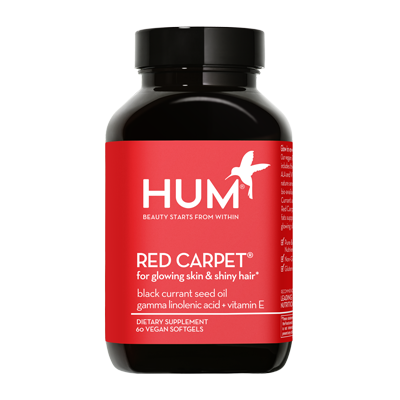What Is GLA? The Essential Fatty Acid For Dry Skin
Here’s why GLA, an essential fatty acid, is so good for your skin and body.
Experiencing dry, flaky, and textured skin? For some people it happens all year round (and gets worse in the biting cold during the winter). Before you go out and spend a ton on moisturizing products, consider tackling dryness from the inside out with GLA.
Yes, the fatty acid gamma linoleic acid (GLA) has some benefits for your skin and its moisture barrier, but more on that later. Beyond that, the potential GLA benefits include PMS relief (sign us up) and even good joint health.
We’ll tackle all your questions, including “what is GLA?” to start with, below.
What Is GLA?
GLA is short for gamma-linolenic acid, and GLA fatty acid is a special member of the omega-6 fatty acid family. Some of you might read that and think, “Aren’t those the bad fatty acids?” Sadly, omega-6 fatty acids can get a bad rep. (They’re usually found in vegetable oils.) Meanwhile, their counterpart omega-3s have a more flattering reputation. But before you ban all omega-6 fatty acids from your diet, let’s get into whether there really is such a thing as a good or bad fatty acid.
In fact, researchers from The Center for Genetics, Nutrition, and Health say otherwise. They advise that a balanced ratio of both omega-3 and omega-6 fatty acids is healthier than simply avoiding omega-6 fatty acids altogether. Here’s where GLA comes in. It’s a less commonly consumed omega-6, but is actually just as good for your health as omega-3 fatty acids. Here are some of the main benefits you can get from incorporating a healthy source of GLA into your diet.
GLA Benefits
Skin
By now, many studies show the positive effects of GLA for skin. At Oregon State University, for example, test subjects who consumed GLA daily for 12 weeks all demonstrated GLA skin benefits, like firmer and more elastic skin. They also had less transepidermal water loss, or TEWL. TEWL is the technical term for dry skin. It’s also one of the main underlying causes for premature aging. Many protective layers comprise our skin that are designed to keep moisture in and keep out harmful cells. When we experience TEWL, it’s because the protective layers of our skin have been disrupted. It can happen for a variety of reasons including extreme weather conditions, dehydration, and nutritional deficiencies.

GLA helps prevent moisture loss by strengthening the protective barriers of our skin. Think of it as an internal serum that is locking in moisture for supple-looking skin. Increasing moisture retention is key for keeping fine lines at bay. Other GLA benefits for skin include improving skin conditions related to inflammation, such as eczema and psoriasis.
PMS Relief
Irritability, cramps, back pain, breast tenderness… You may know these all too well as classic (not to mention highly unpleasant) PMS symptoms. These inflammatory conditions naturally occur as our bodies prepare to menstruate. Even worse, a diet lacking the right balance of omega fatty acids exacerbates the effects. For that reason, taking GLA can actually help reduce PMS-related inflammation. A recent study published in the Journal of Nursing and Midwifery Sciences states that women who consume GLA daily report a significantly lower severity of symptoms than women who didn’t supplement. As a bonus, taking GLA also has fewer side effects than popular over-the-counter PMS medications!
Weight Loss
Weight loss can be challenging, especially with stubborn fat that just won’t budge. Brown fat (which cushions our organs for protection) can indicate how likely we are to lose white fat (which is mostly energy storage). Studies show active brown fat is associated with individuals at healthy weights. In contrast, inactive or dormant brown fat may be linked to obesity.
In her book Eat Fat, Lose Weight, Dr. Ann Louise Gittleman cites one particularly intriguing study from the University of Montreal. They found that GLA can benefit nutrition by stimulating brown fat activity and calorie burn. Yet another study in the Journal of Nutrition reports that GLA can help prevent weight regain in people prone to obesity. Another clinical trial set to finish in 2023 is currently measuring the effectiveness of GLA supplementation in preventing weight regain for 24 months. While more research is needed to investigate the effectiveness of GLA for weight loss and weight management, these studies show great promise.
Healthy Joints
The OCL Journal highlights GLA’s anti-inflammatory properties as being elemental in reducing painful symptoms associated with arthritis. Arthritis is a condition typically treated with anti-inflammatory drugs. However, daily consumption of GLA may help ease bone stiffness, swelling, and relieve painful joints. The same review claims that some patients even report that the severity of their arthritis symptoms dropped from 100 percent to about 25 percent after nine months of GLA supplementation. Amazing!

How Much GLA Do We Need?
It’s important to know that our bodies don’t produce GLA, which means we must get it from our diet. However, it turns out GLA is actually one of the rarest forms of omega-6 fatty acids, and people with dry skin conditions like eczema might have a GLA deficiency, according to research published in the European Journal of Pharmacology. For that reason, health experts recommend taking GLA supplements. So how do you find the best GLA supplement?
Black currant seed oil, like that found in HUM’s Red Carpet supplement, is one of the best GLA supplements in that it is a very efficient way to get maximum GLA benefits. We suggest a 300 to 2000 milligram dosage for maximum efficacy. Results typically start to show after consuming GLA daily for three to six weeks.
Are There Any Side Effects of GLA?
It’s unlikely that you’d experience any major side effects of GLA. If anything, you could have mild digestive symptoms like nausea and diarrhea, or headaches. Those would most likely occur if you went over the 2000 milligram suggested dosage, though.
Is GLA Safe for Everyone to Take?
Most people will tolerate GLA well, especially if they stay within that 300 to 2000 milligram suggested dosage. But it’s a good idea to speak with your doctor before adding GLA to your supplement routine if you are taking certain medications, including blood thinners. When combined with anticoagulants, or blood thinners, GLA supplements might increase your risk for bleeding. The same risk goes for seizures. Check with your doctor if you’re prone to seizures or taking seizure medications, as GLA could potentially elevate your risk.
If you’re currently pregnant or breastfeeding, you should talk to your OB/GYN before starting any supplements that aren’t prenatal vitamins, including GLA supplements. There isn’t enough research on GLA’s safety profile for anyone who’s pregnant or breastfeeding.

7 Types of Rest You Should Be Getting to Avoid Burnout and Amplify Happiness

What Is Ayurveda? An Expert Breaks Down Everything to Know About This Ancient Health Practice

If You Thought The Mediterranean Diet Couldn’t Get Any Better, Try The Green Mediterranean Diet






